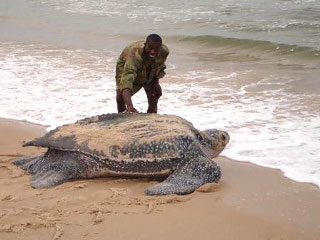

 | |||||||||
|
|
Journals 2009/2010Beth Brocato
September 17, 2009 We are still hitting the southern stations and finding a large diversity of fish. However the exciting find of the day was a leatherback turtle.
Leatherback turtles are on the endangered species list. Because of that, we were not allowed to take pictures of the turtle on the boat. This leatherback weighed about 300 lbs. It took 4 men to put it in a sling attached to a crane to weigh it. Apparently, this is a juvenile turtle, because they adults can get as large as 2000lbs.! Leatherback turtles are the largest living turtle. The team quickly tagged the turtle with a tracking number and took a small piece of skin from its back flipper so it can be genetically identified later. The reason they are so endangered is that the large females must come up on beaches to lay their eggs. Because of humans, many beach habitats have been developed and the turtles have few places to safely lay their eggs. In addition, when the baby turtles hatch, they have a few moments to reach the sea before they are picked off by birds and other land predators. Leatherbacks feed on jellyfish. A great many turtles have died when they mistakenly digest plastic grocery bags, thinking they are jellyfish. After tagging this turtle, it was released back in the water to continue the fight of the Leatherback turtle. |
||||||||
